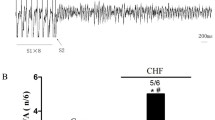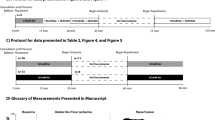Abstract
Purpose
We compared the negative chronotropic and inotropic effects of landiolol and esmolol, two clinically available short-acting β1-blockers with high β1-selectivity, using whole isolated rabbit heart preparations.
Methods
Tachycardia was induced by continuous perfusion of 10−7 M isoproterenol, and we used concentrations of landiolol or esmolol in ascending steps (1 · 10−6, 3 · 10−6, 1 · 10−5, 3 · 10−5, and 1 · 10−4 M). Heart rate (HR), left ventricular developed pressure (LVDP), the maximal rates of left ventricular force development (LVdP/dtmax), and myocardial oxygen consumption (MVO2) were measured and compared.
Results
Both landiolol and esmolol produced dosedependent decreases in HR, LVDP, LVdP/dtmax, and MVO2. The HR lowering effects of the two agents were comparable. At concentrations of 3 · 10−5 and 1 · 10−4 M, esmolol produced more profound depression of LVDP (47 ± 26 and 12 ± 11 mmHg, respectively; mean ± SD) and reduction of LVdP/dtmax (650 ± 287 and 120 ± 103 mmHg·s−1) than landiolol (68 ± 20 and 64 ± 20 mmHg, and 897 ± 236 and 852 ± 240 mmHg·s−1, respectively). At the same concentrations, esmolol caused more profound reduction in MVO2 (40 ± 11 and 35 ± 10 μl·min−1 · g−1) than landiolol (50 ± 8 and 48 ± 8 μl·min−1 · g−1), respectively.
Conclusion
Our results indicate that in the isolated rabbit heart, landiolol and esmolol had equipotent negative chronotropic effects, however, landiolol had a less potent negative inotropic effect than esmolol.
Similar content being viewed by others
References
Wallace A, Layug B, Tateo I, Li J, Hollenberg M, Browner W, Miller D, Mangano DT. Prophylactic atenolol reduces postoperative myocardial ischemia. McSPI Research Group. Anesthesiology. 1998;88:7–17.
Mangano DT, Layug EL, Wallace A, Tateo I. Effect of atenolol on mortality and cardiovascular morbidity after noncardiac surgery. Multicenter Study of Perioperative Ischemia Research Group. N Engl J Med. 1996;335:1713–1720.
American College of Cardiology/American Heart Association Task Force on Practice Guidelines (Writing Committee to Revise the 2002 Guidelines on Perioperative Cardiovascular Evaluation for Noncardiac Surgery); American Society of Echocardiography; American Society of Nuclear Cardiology; Heart Rhythm Society; Society of Cardiovascular Anesthesiologists; Society for Cardiovascular Angiography and Interventions; Society for Vascular Medicine and Biology; Society for Vascular Surgery, Fleisher LA, Beckman JA, Brown KA, Calkins H, Chaikof E, Fleischmann KE, Freeman WK, Froehlich JB, Kasper EK, Kersten JR, Riegel B, Robb JF, Smith SC Jr, Jacobs AK, Adams CD, Anderson JL, Antman EM, Buller CE, Creager MA, Ettinger SM, Faxon DP, Fuster V, Halperin JL, Hiratzka LF, Hunt SA, Lytle BW, Nishimura R, Ornato JP, Page RL, Riegel B, Tarkington LG, Yancy CW. ACC/AHA 2007 guidelines on perioperative cardiovascular evaluation and care for noncardiac surgery: executive summary: a report of the American College of Cardiology/American Heart Association Task Force on Practice Guidelines (Writing Committee to Revise the 2002 Guidelines on Perioperative Cardiovascular Evaluation for Noncardiac Surgery). Anesth Analg. 2008;106:685–712.
Gorczynski RJ. Basic pharmacology of esmolol. Am J Cardiol. 1985;56:3F–13F.
Kirshenbaum JM, Kloner RA, Antman EM, Braunwald E. Use of an ultra short-acting beta-blocker in patients with acute myocardial ischemia. Circulation. 1985;72:873–880.
Jacobs JR, Maier GW, Rankin JS, Reves JG. Esmolol and left ventricular function in the awake dog. Anesthesiology. 1985;68:373–378.
Deegan R, Wood AJ. Beta-receptor antagonism does not fully explain esmolol-induced hypotension. Clin Pharmacol Ther. 1994;56:223–228.
Iguchi S, Iwamura H, Nishizaki M, Hayashi A, Senokuchi K, Kobayashi K, Sakaki K, Hachiya K, Ichioka Y, Kawamura M. Development of a highly cardioselective ultra short-acting beta-blocker, ONO-1101. Chem Pharm Bull. 1992;40:1462–1469.
Sasao J, Tarver SD, Kindscher JD, Taneyama C, Benson KT, Goto H. In rabbits, landiolol, a new ultra-short-acting β-blocker, exerts a more potent negative chronotropic effect and less effect on blood pressure than esmolol. Can J Anaesth. 2001;48:985–989.
Motomura S, Hagihara A, Narumi Y, Hashimoto K. Time course of a new ultrashort-acting beta-adrenoceptor-blocking drug, ONO-1101: comparison with those of esmolol and propranolol by using the canine isolated, blood-perfused heart preparations. J Cardiovasc Pharmacol. 1998;31:431–440.
Sugiyama A, Takahara A, Hashimoto K. Electrophysiologic, cardiohemodynamic and beta-blocking actions of a new ultrashort-acting beta-blocker, ONO-1101, assessed by the in vivo canine model in comparison with esmolol. J Cardiovasc Pharmacol. 1999;34:70–77.
Riess ML, Kevin LG, Camara AK, Heisner JS, Stowe DF. Dual exposure to sevoflurane improves anesthetic preconditioning in intact hearts. Anesthesiology. 2004;100:569–574.
Murakami M, Furuie H, Matsuguma K, Wanibuchi A, Kikawa S, Irie S. Pharmacokinetics and pharmacodynamics of landiolol hydrochloride, an ultra short-acting beta1-selective blocker, in a dose escalation regimen in healthy male volunteers. Drug Metab Pharmacokinet. 2005;20:337–344.
Tsunekawa K, Imawaka H, Yamamoto K, Shibakawa K, Hiraku S. Studies on the metabolic fate of ultra short acting β1 blocker ONO-1101 (3): metabolism and protein binding (in Japanese with English abstract). Xenobio Metab Dispos. 1997;12:31–41.
Sum CY, Yacobi A. Gas chromatographic-mass spectrometric assay for the ultra-short-acting beta-blocker esmolol. J Pharm Sci. 1984;73:1177–1179.
Reynolds RD, Gorczynski RJ, Quon CY. Pharmacology and pharmacokinetics of esmolol. J Clin Pharmacol. 1986;26(Suppl A):A3–A14.
Su Z, Li F, Spitzer KW, Yao A, Ritter M, Barry WH. Comparison of sarcoplasmic reticulum Ca2+-ATPase function in human, dog, rabbit, and mouse ventricular myocytes. J Mol Cell Cardiol. 2003;35:761–767.
Arlock P, Wohlfart B, Sjoberg T, Steen S. The negative inotropic effect of esmolol on isolated cardiac muscle. Scand Cardiovasc J. 2005;39:250–254.
Deng CY, Lin SG, Zhang WC, Kuang SJ, Qian WM, Wu SL, Shan ZX, Yang M, Yu XY. Esmolol inhibits Na+ current in rat ventricular myocytes. Methods Find Exp Clin Pharmacol. 2006;28:697–702.
Kuhn-Regnier F, Natour E, Dhein S, Dapunt O, Geissler HJ, LaRose K, Gorg C, Mehlhorn U. Beta-blockade versus Buckberg blood-cardioplegia in coronary bypass operation. Eur J Cardiothorac Surg. 1999;15:67–74.
Bessho R, Chambers DJ. Myocardial protection: the efficacy of an ultra-short-acting beta-blocker, esmolol, as a cardioplegic agent. J Thorac Cardiovasc Surg. 2001;122:993–1003.
Muraki K, Nakagawa H, Nagano N, Henmi S, Kawasumi H, Nakanishi T, Imaizumi K, Tokuno T, Atsuki K, Imaizumi Y, Watanabe M. Effects of ONO-1101, a novel beta-antagonist, on action potential and membrane currents in cardiac muscle. J Pharmacol Exp Ther. 1996;278:555–563.
Yamazaki A, Kinoshita H, Shimogai M, Fujii K, Nakahata K, Hironaka Y, Iranami H, Hatano Y. Landiolol attenuates tachycardia in response to endotracheal intubation without affecting blood pressure. Can J Anaesth. 2005;52:254–257.
Biccard BM. Peri-operative beta-blockade and haemodynamic optimization in patients with coronary artery disease and decreasing exercise capacity presenting for major noncardiac surgery. Anaesthesia. 2004;59:60–68.
London MJ, Zaugg M, Schaub MC, Spahn DR. Perioperative beta-adrenergic receptor blockade: physiologic foundations and clinical controversies. Anesthesiology. 2004;100:170–175.
Author information
Authors and Affiliations
About this article
Cite this article
Ikeshita, K., Nishikawa, K., Toriyama, S. et al. Landiolol has a less potent negative inotropic effect than esmolol in isolated rabbit hearts. J Anesth 22, 361–366 (2008). https://doi.org/10.1007/s00540-008-0640-4
Received:
Accepted:
Published:
Issue Date:
DOI: https://doi.org/10.1007/s00540-008-0640-4




